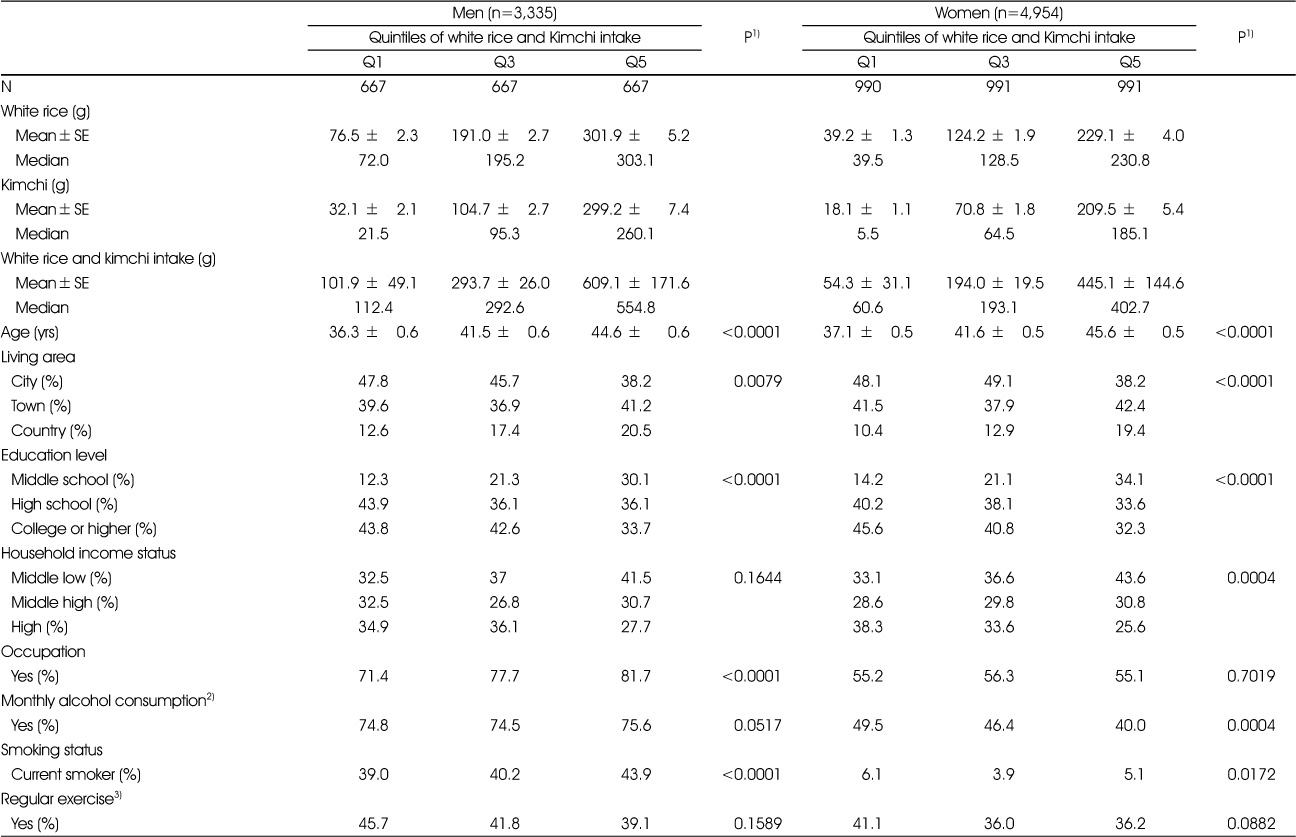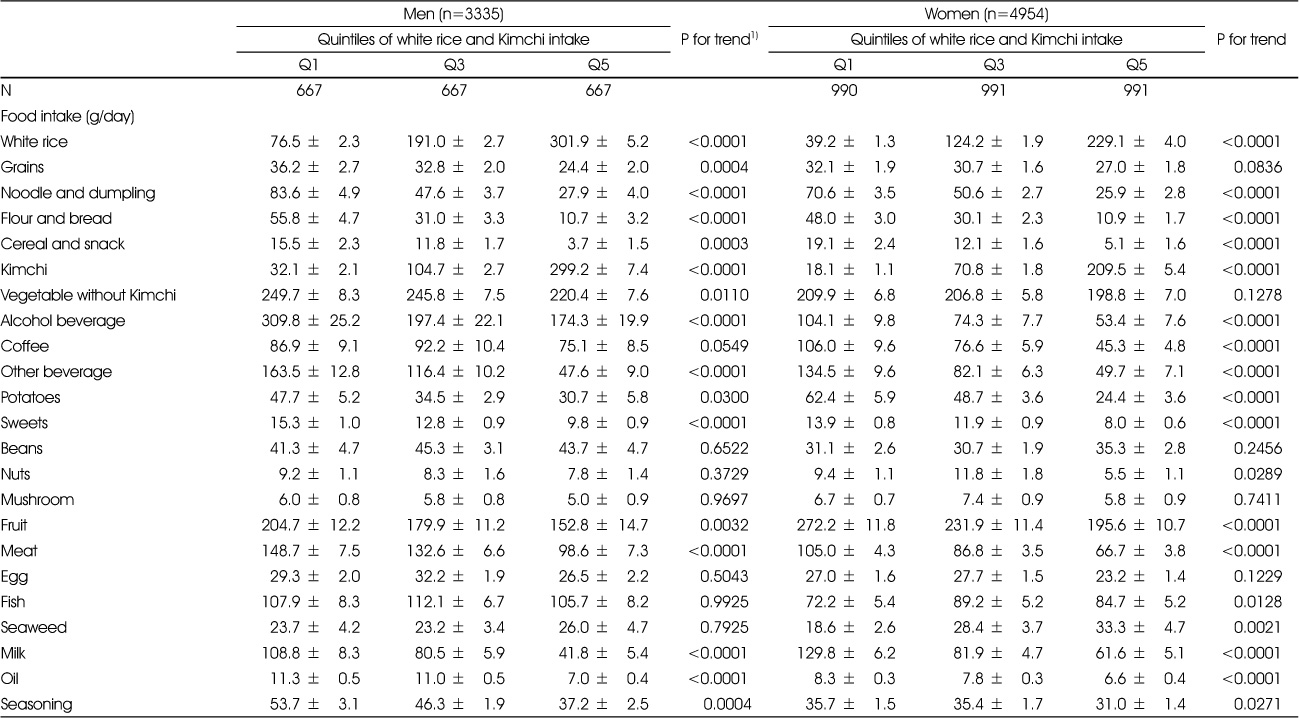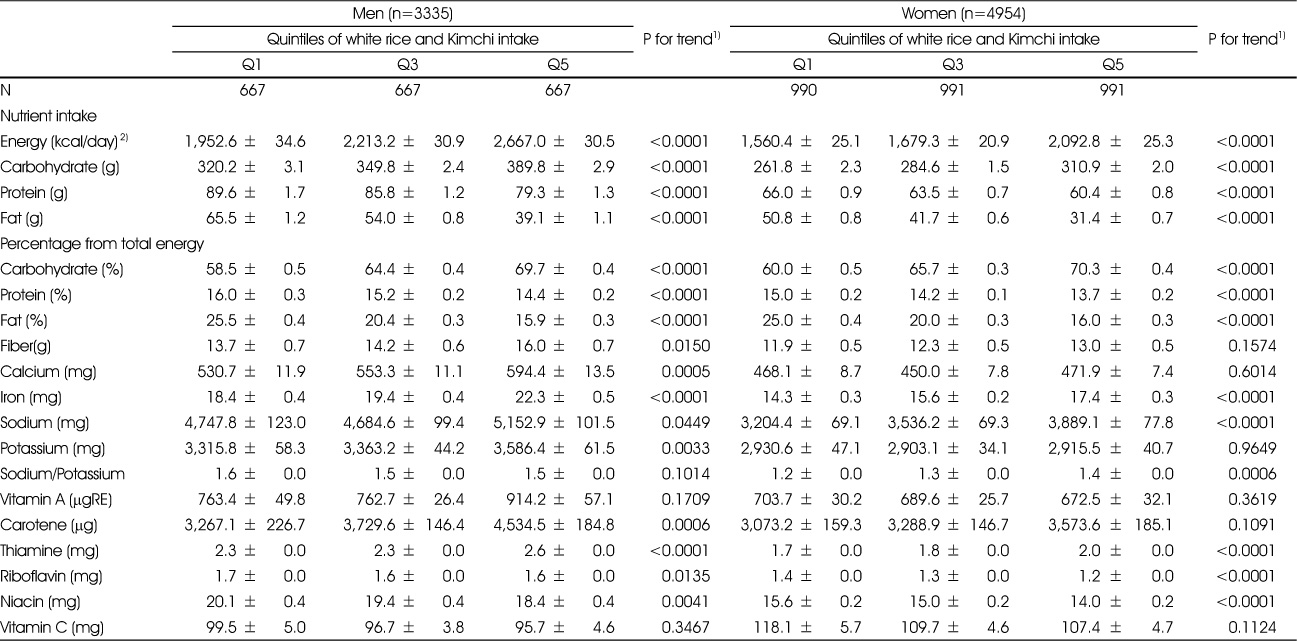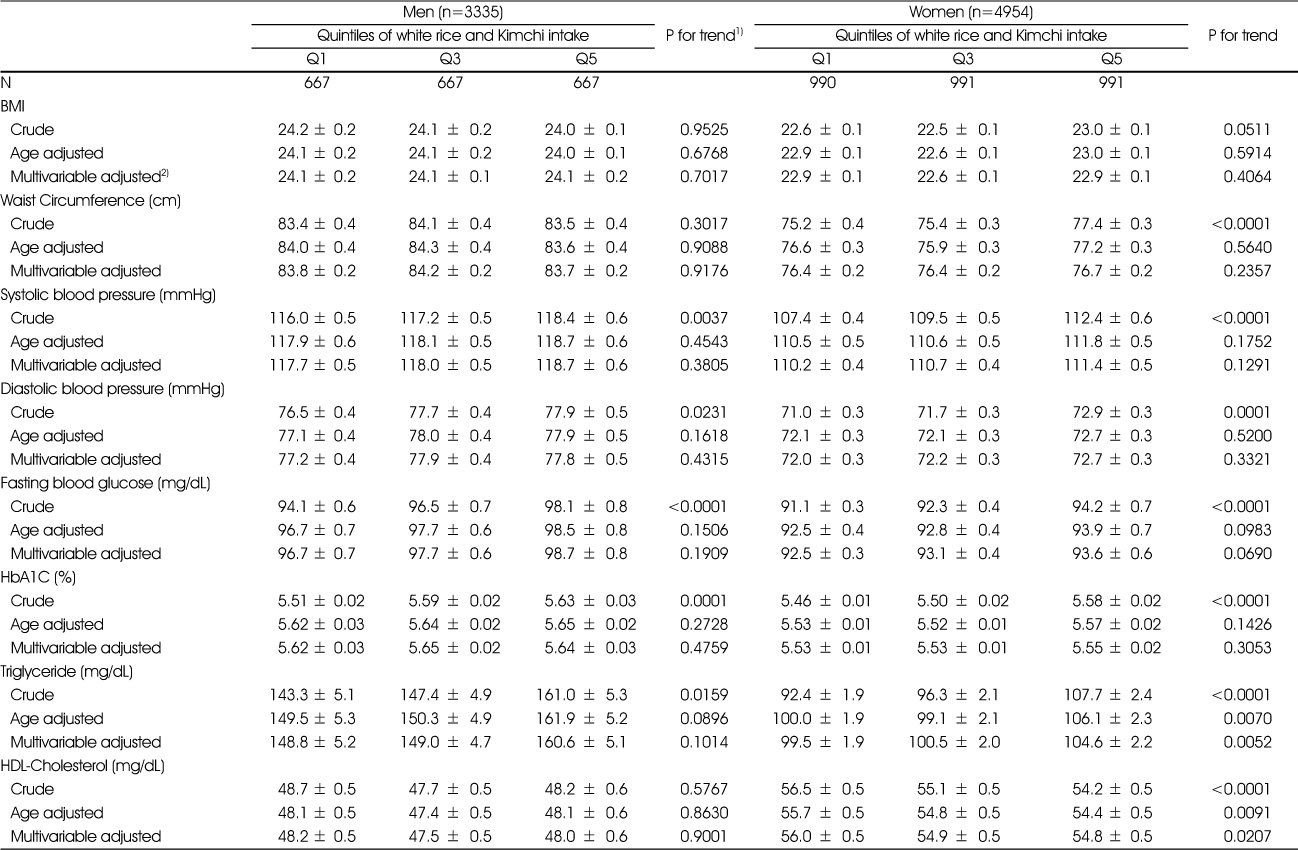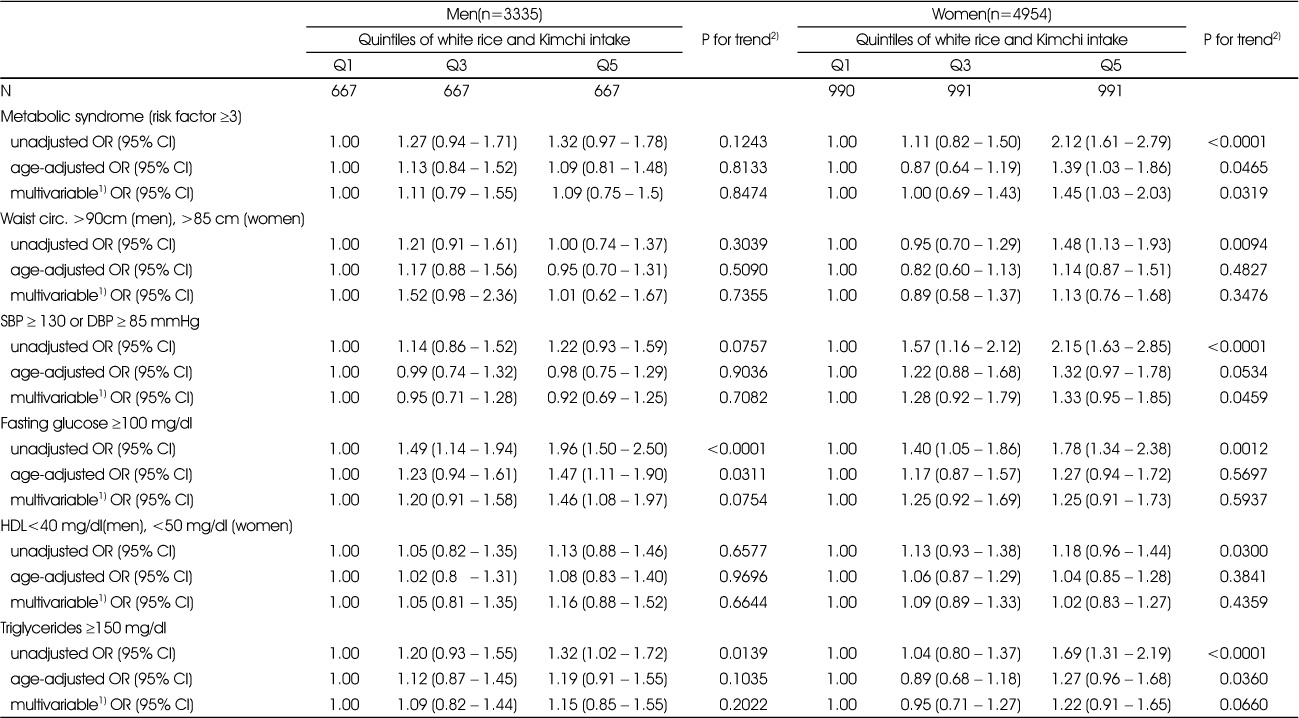References
1. Grundy SM, Cleeman JI, Daniels SR, Donato KA, Eckel RH, Franklin BA, et al. Diagnosis and management of the metabolic syndrome: an American Heart Association/National Heart, Lung, and Blood Institute scientific statement. Circulation 2005;112(17):2735–2752.
2. Reaven GM. Role of insulin resistance in human disease. Diabetes 1988;37(12):1595–1607.
3. DeFronzo RA, Ferrannini E. Insulin resistance: a multifaceted syndrome responsible for NIDDM, obesity, hypertension, dyslipidemia, and atherosclerotic cardiovascular disease. Diabetes Care 1991;14(3):173–194.
4. Grundy SM, Brewer HB Jr, Cleeman JI, Smith SC Jr, Lenfant C. Definition of metabolic syndrome: report of the National Heart, Lung, and Blood Institute/American Heart Association conference on scientific issues related to definition. Circulation 2004;109(3):433–438.
5. Lim S, Shin H, Song JH, Kwak SH, Kang SM, Yoon JW, et al. Increasing prevalence of metabolic syndrome in Korea: The Korean National Health and Nutrition Examination Survey for 1998-2007. Diabetes Care 2011;34(6):1323–1328.
6. Tran BT, Jeong BY, Oh JK. The prevalence trend of metabolic syndrome and its components and risk factors in Korean adults: results from the Korean National Health and Nutrition Examination Survey 2008–2013. BMC Public Health 2017;17(1):71–78.
7. Aguilar M, Bhuket T, Torres S, Liu B, Wong RJ. Prevalence of the metabolic syndrome in the United States, 2003-2012. JAMA 2015;313(19):1973–1974.
8. Song Y, Joung H. A traditional Korean dietary pattern and metabolic syndrome abnormalities. Nutr Metab Cardiovasc Dis 2012;22(5):456–462.
9. Ahn Y, Park SJ, Kwack HK, Kim MK, Ko KP, Kim SS. Rice-eating pattern and the risk of metabolic syndrome especially waist circumference in Korean Genome and Epidemiology Study(KoGES). BMC Public Health 2013;13(1):61–71.
10. Song SJ, Lee JE, Paik H, Park MS, Song YJ. Dietary patterns based on carbohydrate nutrition are associated with the risk for diabetes and dyslipidemia. Nutr Res Pract 2012;6(4):349–356.
11. Song SJ, Lee JE, Song WO, Paik H, Song Y. Carbohydrate intake and refined-grain consumption are associated with metabolic syndrome in the Korean adult population. J Acad Nutr Diet 2014;114(1):54–62.
12. Kang JH, Kim KA, Han JS. Korean diet and obesity. J Korean Soc Study Obes 2004;13(1):34–41.
13. Kim J, Jo I. Grains, vegetables, and fish dietary pattern is inversely associated with the risk of metabolic syndrome in South Korean adults. J Am Diet Assoc 2011;111(8):1141–1149.
14. Lim H, Kim SY, Wang Y, Lee SJ, Oh K, Sohn CY, et al. Preservation of a traditional Korean dietary pattern and emergence of fruit and dairy dietary pattern among adults in South Korea : secular transitions in dietary patterns of a prospective study from 1998 to 2010. Nutr Res 2014;34(9):760–770.
15. Joung H, Hong S, Song Y, Ahn BC, Park MJ. Dietary patterns and metabolic syndrome risk factors among adolescents. Korean J Pediatr 2012;55(4):128–135.
16. Kim HJ, Ju SY, Park CR, Park YK. Relationship between Kimchi and metabolic syndrome in Korean adults: data from the Korea National Health and Nutrition Examination Surveys (KNHANES) 2007~2012. J Korean Diet Assoc 2016;22(3):151–162.
17. Hyun T, Seo SH, Han YH, Song Y. Kimchi consumption and the incidence of metabolic syndrome in Korean adults : results from 10-year longitudinal study. FASEB J 2017;31(1S):789-7.15.
18. Son SM, Park YS, Lim HJ, Kim SB, Jeong YS. Sodium intakes of Korean adults with 24-hour urine analysis and dish frequency questionnaire and comparison of sodium intakes according to the regional area and dish group. Korean J Community Nutr 2007;12(5):545–558.
19. Yon M, Lee Y, Kim D, Lee J, Koh E, Nam E, et al. Major sources of sodium intake of the Korean population at prepared dish level: -based on the KNHANES 2008–2009. Korean J Community Nutr 2011;16(4):473–487.
20. Song DY, Park JE, Shim JE, Lee JE. Trends in the major dish groups and food groups contributing to sodium intake in the Korea National Health and Nutrition Examination Survey 1998–2010. Korean J Nutr 2013;46(1):72–85.
21. Yoo JE, Kim JS, Son SM. Risk of metabolic syndrome according to intakes of vegetables and Kimchi in Korean adults: Using the 5th Korea National Health and Nutrition Examination Survey 2010-2011. Korean J Community Nutr 2017;22(6):507–519.
22. Kim MK, Kim K, Shin MH, Shin DH, Lee YH, Chun BY, et al. The relationship of dietary sodium, potassium, fruits and vegetables intake with blood pressure among Korean adults aged 40 and elder. Nutr Res Pract 2014;8(4):453–462.
23. Kang M, Joung H, Lim JH, Lee YS, Song YJ. Secular trend in dietary patterns in a Korean adult population, using the 1998, 2001, and 2005 Korean National Health and Nutrition Examination Survey. Korean J Nutr 2011;44(2):152–161.
24. Parks EJ, Hellerstein MK. Carbohydrate-induced hypertriacylglycerolemia: historical perspective and review of biological mechanisms. Am J Clin Nutr 2000;71(2):412–433.
25. The Ministry of Health and Welfare. The Korean Nutrition Society. Dietary reference intakes for Koreans 2nd revisionnd ed. Seoul: The Korean Nutrition Society; 2015.
26. Villegas R, Liu S, Gao Y, Yang G, Li H, Zheng W, et al. Prospective study of dietary carbohydrates, glycemic index, glycemic load, and incidence of type 2 diabetes mellitus in middle-aged Chinese women. Arch Intern Med 2007;167(21):2310–2316.
27. Murakami K, Sasaki S, Takahashi Y, Okubo H, Hosoi Y, Horiguchi H, et al. Dietary glycemic index and load in relation to metabolic risk factors in Japanese female farmers with traditional dietary habits. Am J Clin Nutr 2006;83(5):1161–1169.
28. Radhika G, Van Dam RM, Sudha V, Ganesan A, Mohan V. Refined grain consumption and metabolic syndrome in urban Asian Indians (Chennai Urban Rural Epidemiology Study 57). Metab Clin Exp 2009;58(5):675–681.
29. Kim K, Yun SH, Choi BY, Kim MK. Cross-sectional relationship between dietary carbohydrate, glycaemic index, glycaemic load and risk of the metabolic syndrome in a Korean population. Br J Nutr 2008;100(3):576–584.
30. Choi H, Song S, Kim J, Chung J, Yoon J, Paik H. High carbohydrate intake was inversely associated with high-density lipoprotein cholesterol among Korean adults. Nutr Res 2012;32(2):100–106.
31. Park SH, Lee KS, Park HY. Dietary carbohydrate intake is associated with cardiovascular disease risk in Korean: analysis of the third Korea National Health and Nutrition Examination Survey. Int J Cardiol 2010;139(3):234–240.
32. Gaziano JM, Buring JE, Breslow JL, Goldhaber SZ, Rosner B, Van B, et al. Moderate alcohol intake, increased levels of high-density lipoprotein and its subfractions, and decreased risk of myocardial infarction. N Engl J Med 1993;329(25):1829–1834.
33. Park SH, Kang YH, Park HY. Alcohol consumption and the coronary heart disease-related risk factors in Korean adults: the Third Korea National Health and Nutrition Examination Survey (KNHANES III) 2005. Korean J Nutr 2008;41(3):232–241.
34. Son SM, Huh GY. Dietary risk factors associated with hypertension in patients. Korean J Community Nutr 2006;11(5):661–672.
35. Appel LJ, Brands MW, Daniels SR, Karanja N, Elmer PJ, Sacks FM. Dietary approaches to prevent and treat hypertension: a scientific statement from the American Heart Association. Hypertension 2006;47(2):296–308.
36. Morris RC Jr, Sebastian A, Forman A, Tanaka M, Schmidlin O. Normotensive salt sensitivity effects of race and dietary potassium. Hypertension 1999;33(1):18–23.
37. de La Iglesia R, Loria-Kohen V, Zulet MA, Martinez JA, Reglero G, Ramirez de Molina A. Dietary strategies implicated in the prevention and treatment of metabolic syndrome. Int J Mol Sci 2016;17(11):pii: E1877.
38. Chen JP, Chen GC, Wang XP, Qin L, Bai Y. Dietary fiber and metabolic syndrome: A meta-analysis and review of related mechanism. Nutrients 2017;10(1):pii: E24.
39. Kang Y, Kim J. Gender difference on the association between dietary patterns and metabolic syndrome in Korean population. Eur J Nutr 2016;55(7):2321–2330.
40. Nanri A, Mizoue T, Noda M, Takahashi Y, Kato M, Inoue MS. Rice intake and type 2 diabetes in Japanese men and women the Japan Public Health Center: Based Prospective Study. Am J Clin Nutr 2010;92(6):1468–1477.

